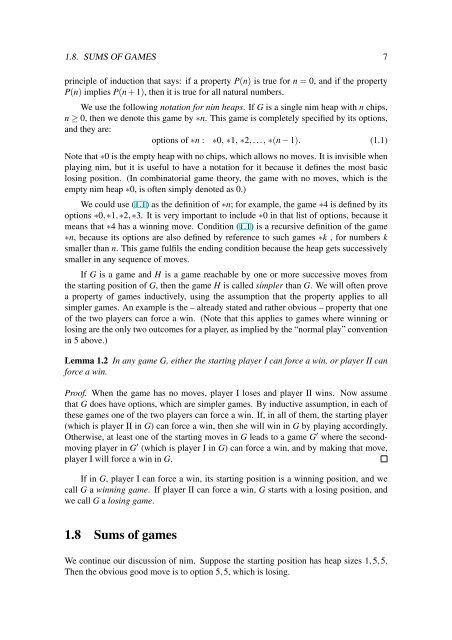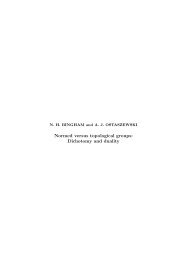Game Theory Basics - Department of Mathematics
Game Theory Basics - Department of Mathematics
Game Theory Basics - Department of Mathematics
You also want an ePaper? Increase the reach of your titles
YUMPU automatically turns print PDFs into web optimized ePapers that Google loves.
1.8. SUMS OF GAMES 7principle <strong>of</strong> induction that says: if a property P(n) is true for n = 0, and if the propertyP(n) implies P(n + 1), then it is true for all natural numbers.We use the following notation for nim heaps. If G is a single nim heap with n chips,n ≥ 0, then we denote this game by ∗n. This game is completely specified by its options,and they are:options <strong>of</strong> ∗n : ∗0, ∗1, ∗2,..., ∗(n − 1). (1.1)Note that ∗0 is the empty heap with no chips, which allows no moves. It is invisible whenplaying nim, but it is useful to have a notation for it because it defines the most basiclosing position. (In combinatorial game theory, the game with no moves, which is theempty nim heap ∗0, is <strong>of</strong>ten simply denoted as 0.)We could use (1.1) as the definition <strong>of</strong> ∗n; for example, the game ∗4 is defined by itsoptions ∗0,∗1,∗2,∗3. It is very important to include ∗0 in that list <strong>of</strong> options, because itmeans that ∗4 has a winning move. Condition (1.1) is a recursive definition <strong>of</strong> the game∗n, because its options are also defined by reference to such games ∗k , for numbers ksmaller than n. This game fulfils the ending condition because the heap gets successivelysmaller in any sequence <strong>of</strong> moves.If G is a game and H is a game reachable by one or more successive moves fromthe starting position <strong>of</strong> G, then the game H is called simpler than G. We will <strong>of</strong>ten provea property <strong>of</strong> games inductively, using the assumption that the property applies to allsimpler games. An example is the – already stated and rather obvious – property that one<strong>of</strong> the two players can force a win. (Note that this applies to games where winning orlosing are the only two outcomes for a player, as implied by the “normal play” conventionin 5 above.)Lemma 1.2 In any game G, either the starting player I can force a win, or player II canforce a win.Pro<strong>of</strong>. When the game has no moves, player I loses and player II wins. Now assumethat G does have options, which are simpler games. By inductive assumption, in each <strong>of</strong>these games one <strong>of</strong> the two players can force a win. If, in all <strong>of</strong> them, the starting player(which is player II in G) can force a win, then she will win in G by playing accordingly.Otherwise, at least one <strong>of</strong> the starting moves in G leads to a game G ′ where the secondmovingplayer in G ′ (which is player I in G) can force a win, and by making that move,player I will force a win in G.If in G, player I can force a win, its starting position is a winning position, and wecall G a winning game. If player II can force a win, G starts with a losing position, andwe call G a losing game.1.8 Sums <strong>of</strong> gamesWe continue our discussion <strong>of</strong> nim. Suppose the starting position has heap sizes 1,5,5.Then the obvious good move is to option 5,5, which is losing.
















